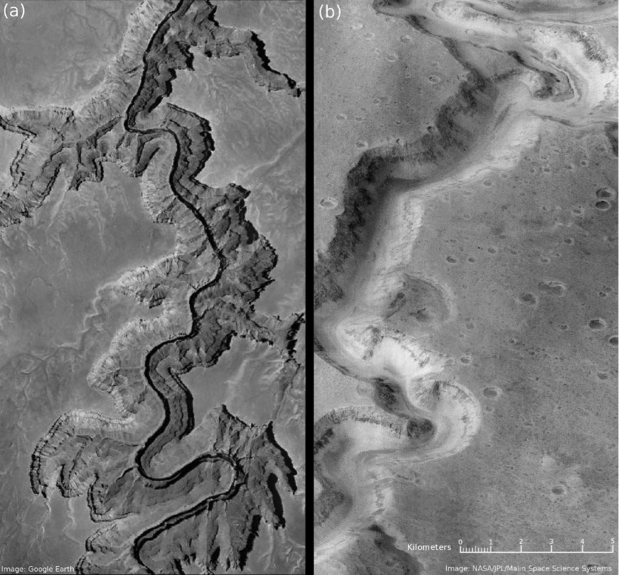
In 1964, Mariner 4 became the first spacecraft to successfully arrive at Mars. While some scientists of the time were expecting a world much like our own, one filled with rivers, oceans, and maybe even life, Mariner’s images instead unveiled a heavily-cratered surface, not unlike the Moon’s. That’s why it was such a surprise when later NASA missions, such as Viking, benefiting from improved technology, revealed a martian landscape more like our Earth’s. These newer images showed large fluvial features in ancient terrains, including the ancient river valley networks, inferred to have formed nearly 4 billion years ago. Therefore, many have argued that Mars may have once possessed a warmer climate, perhaps with a thicker atmosphere that could have supported potentially habitable conditions. Such a warmer early Mars may have been more “Earth-like” in many ways. So, it may be natural to wonder: How Earth-like does a planet need to be to host life? Did Mars ever have life? Does Mars have life now? Scientists operating on Mars could address these and similar questions that ultimately stem from one overriding question: Are we alone in the universe?

The size and scope of the ancient martian valley networks are impressive. Often hundreds of meters deep, and extending for hundreds of kilometers, these immense fluvial features likely required a climate that was warm enough, at least transiently, to have produced enough rain (or snow) to carve them. These valleys would have been difficult to form in a cold climate because much of the water would have been present as ice instead. To be fair, salty water ― known as brines ― perhaps flowing from underground sources, could remain in liquid form at below freezing temperatures. However, it is difficult to envision how a sufficient volume of briny flows to form these massive features could be produced in a cold climate with little precipitation. If the atmosphere was also significantly thinner than the Earth’s, even if surface life had arisen in such a cold climate, that life would have had to contend with less protection from harmful radiation.
Likewise, life has yet to be found on today’s martian surface. The average surface temperatures are well below the freezing point of water. Furthermore, the combination of a tenuous atmosphere and lack of a magnetic field allow harmful solar and cosmic rays to pass through and impact the surface. Nevertheless, it is conceivable that microbial life may currently be living in the planet’s subsurface, shielded from the worst of the radiation. And even if no life exists today, extinct organisms from earlier times may be preserved underground as fossils, waiting to be unearthed by explorers from Earth.
“Humans on Mars is not a capricious whim, but rather is an imperative to scientific progress.”
Moreover, Mars lends itself better to manned scientific exploration than does our other neighbors. For example, modern spacecraft cannot withstand the crushing atmospheric pressures and infernal surface temperatures of Venus. The surface of Venus also appears to have undergone periodic gigantic volcanic eruptions that have engulfed the entire planet in lava numerous times, destroying any potential evidence of fluvial features from an earlier period. Mercury is too hot and close to the Sun. The atmospheres of both the Moon and Mercury are too thin to have ever sustained substantial amounts of liquid water on their surfaces for a significant amount of time, even if both worlds may have some water ice residing in permanently shadowed regions. Thus, Mars presents a unique opportunity as the only neighboring world that exhibits clear observational evidence of a climate that was once warm and wet enough to create extensive fluvial features across its surface, often similar to ones seen on our Earth.
If we imagine that explorers from Earth find fossils proving that life had existed on Mars during this hypothetical early warm period (assuming that scientists rule out possible microbial contamination from the Earth), it may suggest that life has a high probability of emerging under atmospheric conditions not unlike those on our planet. However, even on Earth, we know that certain organisms thrive in extreme conditions very unlike those you or I experience daily on the surface. These extremophiles can withstand extreme heat, cold, acidity, pressures, and even salt content, all at levels that would be deadly to most other Earth life. What if similar hardy micro-organisms are thriving today on Mars’ cold, dry, and irradiated surface? We can only definitively answer such questions by sending scientists to Mars who are dedicated to finding evidence of past or present life. The results of such an endeavor would clarify our perspective as to what is possible even as we speculate about life on the more distant targets of Europa, Enceladus, Titan, and (ultimately) exoplanets.
Humans on Mars is not a capricious whim, but rather is an imperative to scientific progress. Orbiters, rovers, and landers have all made great strides in increasing our understanding of the Red Planet but they cannot replace the judgment, ability to respond to unexpected situations, and sheer ingenuity of human scientists. As much as we have learned about Mars from afar, we would learn so much more by sending people there.
Ramses Ramirez is a planetary scientist and astrobiologist from the Carl Sagan Institute at Cornell University.
This piece is part of a special op-ed series, curated in partnership with Explore Mars, in which contributors from diverse fields such as science, education, policy, business and culture answer a simple question: “Why Mars?” For more, follow the links below or visit exploremars.org.
